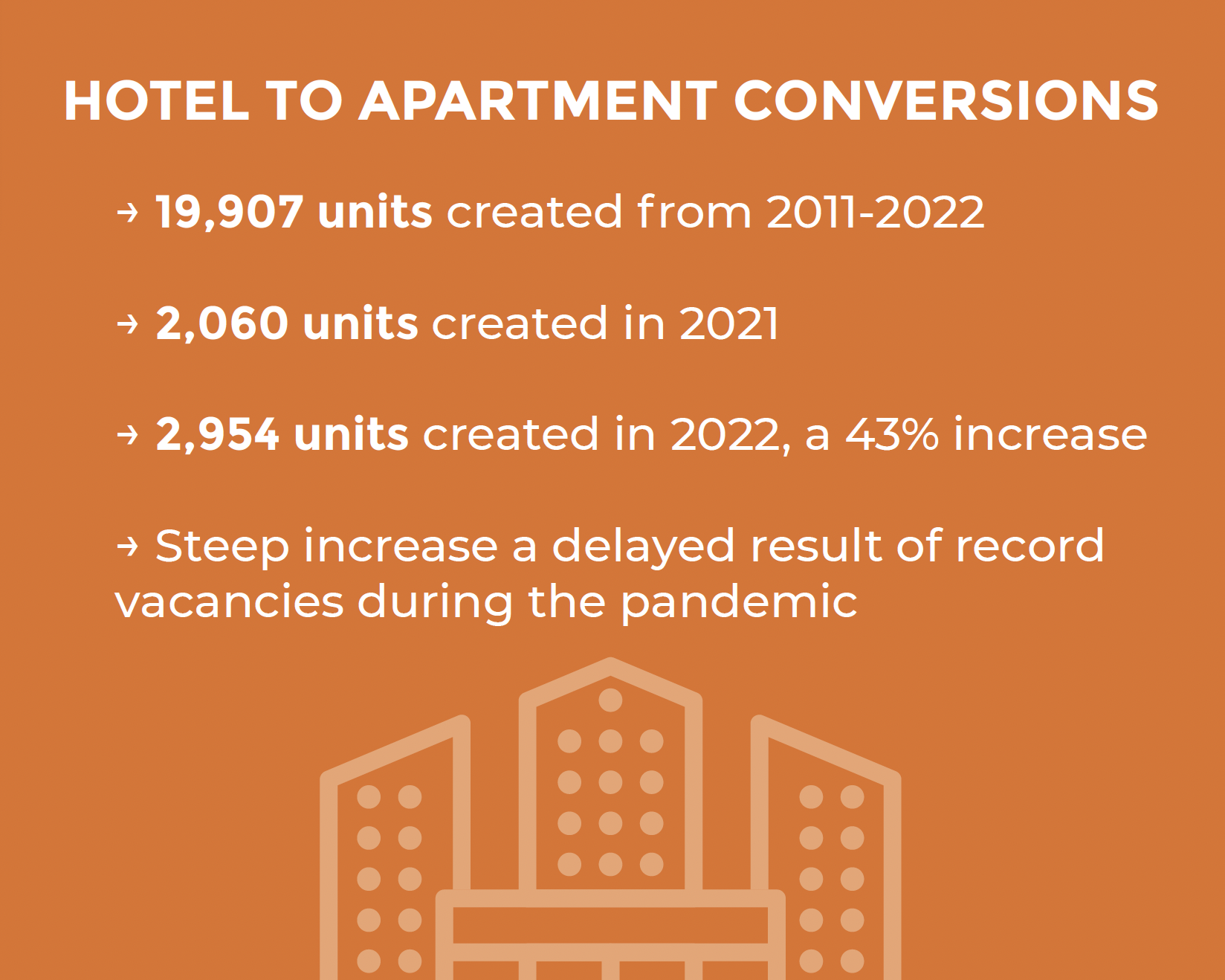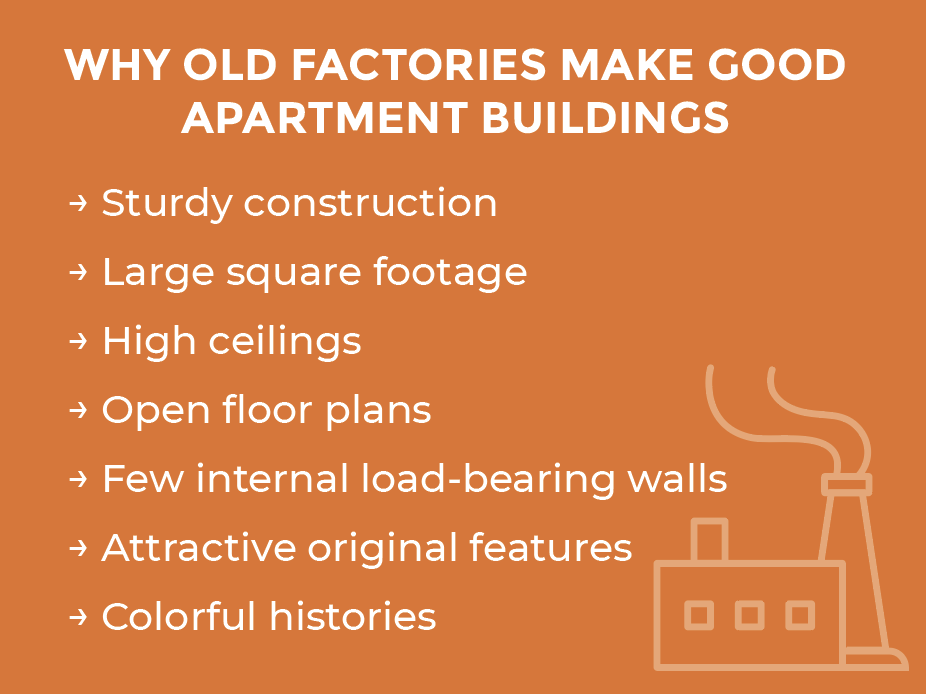Welcome to Part 3 in our series on multifamily conversions.
In Part 3, we delve into factory and hotel conversions, which have been the second and third most popular types of multifamily conversions over the past decade, respectively.
Factory to Apartment Conversions
First, a detailed look at factory conversions.
From the 1950s through 2020, 2,000 former factories were converted to apartments, the most of any type of commercial real estate property.
Unit-wise, from 2011 to 2022, 26,781 apartments were created from factory conversions, second most behind only offices.
However, the number of factory conversions fell dramatically from 2021 to 2022, from 1,849 units to 1,241. The steep, 49% drop was mainly due to the limited stock of old factories suitable for conversion and restrictive zoning laws, factors that will likely continue to slow factory conversions in coming years.
Still, factories accounted for the third most conversions in 2022– 12.3% of total units– behind offices and hotels.
Factors Impacting Factory to Apartment Conversions
Since factories targeted for multifamily conversion were likely vacant long before the pandemic struck, it’s doubtful the pandemic had much of an impact on factory conversions. However, the other factors that have spurred conversions in other property sectors likely have, including the housing shortage in the US, rising home prices and the enduring popularity of city living.
Factories Make Good Multifamily Conversions
Old factories make good candidates for multifamily conversions for several reasons, including:
- Sturdy construction
- Large square footage
- High ceilings
- Open floor plans
- Few internal load-bearing walls
- Attractive, original features, like exposed wooden beams, brick walls and ductwork
- Their often-colorful history; factories that once produced ice cream, cigars, pianos, shoes and even Ovaltine have been converted into apartments
Financial Assistance For Converting Factories to Apartments
Another reason factory conversions appeal to developers and investors is the project may qualify for public financial assistance, including federal historic tax credits, city financing or Tax Increment Financing– known as TIF—in which future property tax revenues from a defined area are used to help offset the cost of an economic development or public improvement project.
Affordable Tax Credits For Multifamily Conversions
Apartments in Old Factories Appeal To Renters
Apartments in converted factories appeal to renters for many of the same reasons they appeal to developers and investors—high ceilings, open floor plans– plus they often offer a unique combination of old and new; original architectural features and embellishments, paired with modern interiors and amenities. The feeling of being connected to local history can be a draw too.
Potential Challenges to Converting Old Factories to Apartments
As with any old building, factories can present their fair share of challenges for developers. Chief among them are:
- Depending on what was manufactured there, an older factory and its grounds may be contaminated by any number of hazardous substances, including lead, copper, mercury and asbestos. If the site is contaminated, remediation will be necessary, which can be very costly and time-consuming, even with government assistance. For that reason, a thorough environmental survey and physical inspection should be conducted on any old factory site before committing to a conversion.
- A good example is the conversion to apartments of the former Peters Cartridge Factory in Lebanon, OH. Bullets and ammunition were manufactured at the factory for decades, leaving the site heavily polluted with lead, mercury and copper. Because the site was so polluted, it sat empty and neglected for 52 years, until the EPA paved the way for a cleanup and then a creative and persistent developer converted it into a mixed-use development with 134 apartments31.
- Structural damage, including to walls, floors, girders, support beams and roofs.
- Old, outdated mechanical systems, including plumbing, electrical, boilers and elevators. Because the mechanical systems for apartment buildings are very different from the mechanical systems for factories, these will likely need to be replaced anyway.
Hotel to Apartment Conversions
 Between 2011 and 2022, hotels were converted into 19,907 multifamily units, third most of any type of property behind offices and factories32.
Between 2011 and 2022, hotels were converted into 19,907 multifamily units, third most of any type of property behind offices and factories32.
The number of hotel to apartment conversions has been on the rise the last five years, from 801 units in 2018 to 1,696 units in 2020 to 2,954 units in 2022.
In 2020 and 2021, the peak years of the pandemic, 216 hotels were converted into 3,908 apartments, the most conversions by property type during that period33.
The 2,954 units created in 2022 accounted for 29.3% of all multifamily conversions that year, second most behind offices. It was a 43% increase from 2021, the steep jump mainly being a delayed result of the record hotel vacancies at the height of the pandemic.
Hotels Were Hit Especially Hard By The Pandemic
The pandemic hit hotels particularly hard in 2020, plunging the occupancy rate to 36.7% in December, down from 66.1% the previous year. In April 2020, 8 in 10 hotel rooms were vacant, an astonishing statistic. Hotel Revenue Per Available Room (RevPAR), also took a huge hit in 2020, falling 60% from 2019, from $86.8 to $3435.
Upscale Hotels Were Hurt Worst By The Pandemic
Upscale hotels, which cater to business and group travelers, were hit hardest by the pandemic, with combined revenues from the Marriott, Hilton, Hyatt and IHG chains dropping 50-60% from 2019 to 2020. By contrast, revenue for midscale hotel operator Choice Hotels International dropped only 30% during that period. Average RevPAR for the hotel industry is not expected to recover to pre-pandemic levels until 202436.
Hotels Are Losing Market Share to Short-Term Rentals
While much of hotels’ on-going struggles can be blamed on the pandemic, Covid-19 hastened trends that already existed. Prior to the onset of the pandemic, hotels had steadily been losing market share to short-term rental companies, like Airbnb and Vrbo, as consumer preferences shifted from traditional hotel lodging to more authentic and localized travel experiences.
In 2020, while hotel vacancies skyrocketed and revenue cratered, Airbnb totaled $23.8 billion in gross worldwide bookings, exceeding the combined gross revenues of the Marriott, Hyatt, IHG and Choice Hotels chains37. By the end of 2021, the US vacation rental industry was valued at $15.1 billion and had the potential to generate $17.66 billion in revenue in 2022.
Extended Stay Hotels Are Best For Multifamily Conversion
Although many types of hotels have been converted into apartments, extended stay hotels tend to work best because the units already have multiple rooms and ample windows and are usually equipped with kitchenettes. Also, the mechanical systems in extended stay hotels, like electrical, plumbing and elevators, generally don’t require major updates or changes, since they’re similar to the mechanical systems in multifamily buildings. In addition, limited-service hotels generally are less expensive to acquire than full-service hotels39.
Sizing Up A Hotel For Conversion to Apartments
When assessing whether a hotel is a good candidate for conversion, other factors to consider include:
- The age of the property. Older properties are likely to have more wear and tear on them and their mechanical systems will be older, so a conversion may require more work, time and money than converting a newer building would. In addition, local building codes may have changed since the hotel was originally built, so the structure might require significant and expensive updates to bring it to code.
- Zoning. The parcel the hotel is on not may not be zoned for apartments, in which case the zoning will need to be changed. This can often be a complex, lengthy and expensive process and sometimes, in the end, the zoning doesn’t get changed anyway, for a variety of reasons.
Affordable Housing Shortage
Hotels have been converted into all classes of apartments, from luxury to temporary homeless shelters. However, most hotel conversions have been to affordable housing, targeting an altogether different group of renters than office, factory or retail multifamily conversions.
Due to the current shortage of affordable housing in this country, demand is high for the affordable apartments created by the conversions. In addition, affordable housing conversions often qualify for Federal financing, including Low Income Housing Tax Credits (LIHTC) and funds from the Home Investment Partnership Program (HOME), increasing their profitability. Also, because Federal agencies measure affordable housing based on the number of units in a development, not the size of the units, hotels are ideal for converting to affordable or Section 8 housing.
Financing Hotel to Apartment Conversions
Developers for hotel to affordable housing conversions typically use private debt or a bridge loan to acquire the property and renovate the units, then convert to more traditional financing once leasing begins40. The Federal Government’s American Rescue Plan Act, which includes $5 billion that can be used for converting properties into housing for the homeless, including hotels, is an additional source of financing for affordable housing conversions41.
Next Up: Converting Struggling Shopping Malls to Apartments
That concludes our discussion on factory and hotel conversions. Next, we’ll take an in-depth look at the growing trend of converting space in struggling shopping malls to apartments.
About The Author
Terry Banike is Realogic’s Vice President of Marketing. Over the course of his career, he has worked in marketing, communications, journalism and public relations, and has written numerous news stories and feature articles for newspapers, trade publications, newsletters and blogs. A rabid reader of anything and everything on commercial real estate, Terry closely follows commercial real estate news and trends and frequently posts about real estate on the Realogic Blog. He can be reached at tbanike@realogicinc.com.
